User Management¶
You can adjust User Management settings and setup or review the registered user list.
Note
When disabled, the user visionCATS_user will be used automatically.
System Settings¶
In this view, you can enable or disable the user management.
Note
The security options and the Users tab are not available when the user management is disabled.
In a similar way to Microsoft Windows, you can set policies for a more secure system:

Minimum user id length
The minimum amount of characters of the user id
Force a password change on first use
Force securer password
The minimum number of rules that a password must follow.
Rules:
your password must have an lower case letter
your password must have an upper case letter
your password must have a number
your password must have a special character
With any level selected, Force securer password will enforce that the password is different than the user id.
Minimum password length
The minimum amount of characters that a password must have
Allow re-use password after
The user can reuse an old password after using others
Force change every
After this time the user must change their password
Lock account after
Max amount of failed logins, after that the account is locked automatically
User should re-enter password after switching to an “open as” item
If check (default), the user must re-enter his password every time he click on a open as tab.
Important
Don’t forget to save the changes!
Users and groups rights¶
Several rights will give users and groups access to some specific features in visionCATS:
Guest: Guest users are limited to the Guest folder
Create/edit analysis: Ability to create (method execution) and edit analysis files
Set read-only flag: Ability to set/unset the read-only flag on explorer items
Create/edit methods: Ability to create and edit methods
Create/edit comparisons: Ability to create and edit comparisons
Import/export: Ability to import/export files in the explorer view
Diagnostics: Ability to perform system diagnostics
System settings: Ability to change the system settings (regulatory settings, substance vial editor) and to perform system actions on explorer items, like restoring obsolete items
HPTLC PRO administrator: Ability to configure the set of HPTLC PRO SYSTEMS (see HPTLC PRO SYSTEM Configuration)
HPTLC PRO execution supervisor: Ability to manage a given HPTLC PRO SYSTEM, notably by managing consumables and executing runs in sequence mode (see Execution)
Licensing: Ability to request and import license keys
User management: Ability to configure the user management system and its accounts
Users¶

All users are displayed in the table. The accounts admin (default system account, not intended to be used) and visionCATS_user (default user used when User Management is not activated), which are not modifiable, are displayed in blue.
Toolbar¶
 Add a new user
Add a new user Add an existing user from Windows or ActiveDirectory
Add an existing user from Windows or ActiveDirectoryIf most users use their own Windows account when working with visionCATS, you can import these Windows users in system, therefore a known Windows user will be automatically logged in.
For adding Windows users, the Windows search window is used:
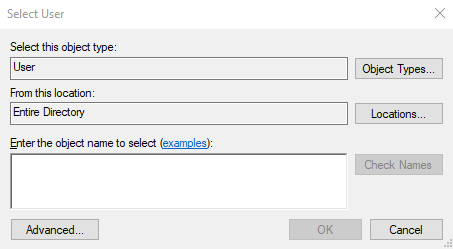
visionCATS Login Name will be set to simple old Windows logon name. The UPN login (User Principal Name), if existing, given by ActiveDirectory will also be linked to visionCATS (the link is done on the security identifier (SID)). Therefore, it is possible to login (or E-Sign) with both type of logon name.
Note
Passwords of Windows users are not stored in the system, and it is not possible to modify them from visionCATS.
Note
Local- or Workgroup-users can also be used.
 Change the password of the currently selected user
Change the password of the currently selected user Update login and name information from Windows or ActiveDirectory (SID should remains the same)
Update login and name information from Windows or ActiveDirectory (SID should remains the same) Toggle the display of locked users (useful if you have a lot of locked users)
Toggle the display of locked users (useful if you have a lot of locked users) The full table can be exported as a report CSV file
The full table can be exported as a report CSV file A PDF report of all users and groups can be exported
A PDF report of all users and groups can be exported
Note
It’s not possible to delete a user because users are referenced in the different actions logged in the system and in the analysis. Instead, use the Lock check box to prevent some users from using visionCATS.
User table¶
For each user (expect system accounts), you can set the following options:
Locked: A locked user can’t log in this visionCATS installation
Login name: Login used in visionCATS, after creation, it cannot be modified
Full name: Real name of the user
Position: Position of the user
Email address: the address used to send notification. See Notifications
Custom rights: indicate whether the users have custom rights or rights defined by group. clicking on the
 icon allows to change the rights (see Users and groups rights):
icon allows to change the rights (see Users and groups rights):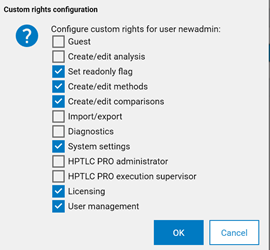
The last columns correspond to each active group defined in the Groups tab. This associates users to groups. Of course, the rights provided by groups are provided to users belonging to these groups.
Tooltips¶
Tooltips help the definition of the users, groups and their associations. On the User table, and in the System Status Bar, the tooltip over the user shows the details of the rights granted and the corresponding groups granting each right:
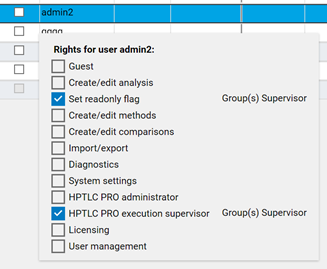
Furthermore, a tooltip on the group column header recalls the associated rights:
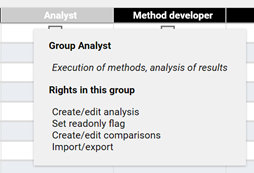
Groups¶

A main list (1) is displayed. There is no priority in groups – they are simply ordered by name.
The selected group details appear under the list (2), where the rights can be configured. The set of users in this group also appear here.
There are built-in groups (3) which cannot be changed. These groups are designed to encourage standard and best practices.
Groups, including built-in ones, can be deactivated (4). Deactivated groups are hidden in all other windows in visionCATS.
Double-click on the Name or Description fields (5) to change the values.
Groups can be added or deleted (non-built-in only) (6)
Toolbar¶
 Add a new group, see New group
Add a new group, see New group Delete a group (non-built-in only)
Delete a group (non-built-in only) A PDF report of all users and groups can be exported
A PDF report of all users and groups can be exported
New group¶
A new group can be added by entering a unique name for the group, and then select the rights (see Users and groups rights):
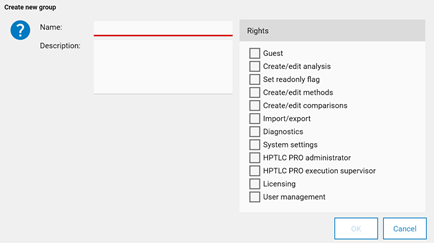
Note
It is possible to create a group with no rights. Users having no rights can still open method/analysis/comparison files in read-only mode.